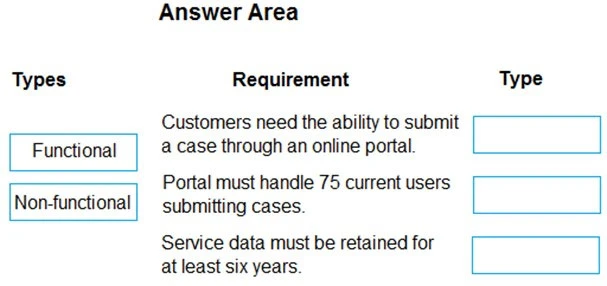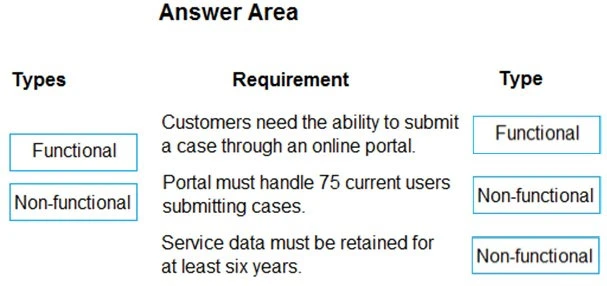The company wants its development team to adopt the construction of repeatable components for its implementation team to reuse on different entities and forms.
You need to recommend a technology that meets these requirements.
Which technology would you recommend the developers adopt to assist the implementation team?
To meet the requirement of constructing repeatable components for use across different entities and forms, the best technology to recommend is the Power Apps Component Framework. This framework allows developers to create reusable code components that can enhance the user experience by being integrated into model-driven and canvas apps. It supports the creation of components that provide consistent and enhanced functionalities across different parts of the application, ensuring that the implementation team has a standardized and efficient way to handle various tasks.
The company has the following requirements:
✑ Provide customers with an online portal where they can submit and review cases.
✑ Ensure that customers can chat online with a customer service representative at any time.
✑ Route chats to customer service representatives based on skill and availability.
You need to recommend a solution to the company.
Which three components should you recommend? Each correct answer presents part of the solution.
NOTE: Each correct selection is worth one point.
To address the company's requirements, the following components should be recommended: A Customer self-service portal provides customers an online space to submit and review cases, addressing the first requirement. Dynamics 365 Virtual Agents chatbots enable customers to chat online at any time, fulfilling the second requirement. Omnichannel for Customer Service routes chats to representatives based on skill and availability, meeting the third requirement. Dynamics 365 Virtual Agents and Omnichannel for Customer Service can be integrated for seamless customer interaction management. Business process flows are more about internal workflows and don't directly address the given requirements.
The Dynamics 365 Sales implementation has security roles that restrict data export. You need to ensure that data has the same restrictions in Power BI as it does in Dynamics 365 Sales.
You need to design the security to avoid sensitive data from being seen.
Which two actions should you recommend? Each correct answer presents part of the solution.
NOTE: Each correct selection is worth one point.
To ensure that data has the same restrictions in Power BI as it does in Dynamics 365 Sales, two actions are necessary: 1) Limiting the role and ensuring that exporting to Microsoft Excel is not allowed in both Dynamics 365 Sales and Power BI. This prevents sensitive data from being exported and ensures data protection across both platforms. 2) Sharing Power BI dashboards only with users who are authorized to see the data. This maintains consistent data visibility restrictions, ensuring sensitive data is only accessible to those with appropriate permissions.
You need to recommend methods for assigning security to each group of users.
The customer provides the following requirements:
✑ Customers need the ability to submit a case through an online portal.
✑ Portal must handle 75 concurrent users submitting cases.
Service data must be retained for at least six years.
You need to determine which requirements are functional or non-functional.
Which requirements are functional or non-functional? To answer, drag the appropriate types to the correct requirements. Each type may be used once, more than once, or not at all. You may need to drag the split bar between panes or scroll to view content.
NOTE: Each correct selection is worth one point.
Select and Place:

Functional requirements describe what the solution needs to do or its behaviors.
Box 2: Non-functional -
Non-functional requirements commonly describe non-behavior aspects of the solution such as performance requirements.
Box 3: Non-functional -
Examples of common non-functional requirement types include:
✑ Availability
✑ Compliance/regulatory
✑ Data retention/residency
✑ Performance (response time, and so on)
✑ Privacy
✑ Recovery time
✑ Security
Scalability -
Reference:
https://docs.microsoft.com/en-us/learn/modules/work-with-requirements/3-functional-requirements https://docs.microsoft.com/en-us/learn/modules/work-with-requirements/4-non-functional-requirements

The company lacks a budget to buy third-party ISVs or add-ons.
The company requires a new system that achieves the following:
✑ All support issues must come in by email, need to be logged, and assigned to the support group.
✑ Accounts must synchronize with the parent company Oracle database.
✑ Reports must be sent to the executives on a weekly basis.
✑ No custom code will be used in the system.
You need to recommend the components that should be configured.
Which two components should you recommend? Each correct answer presents part of the solution.
NOTE: Each correct selection is worth one point.
To meet the requirements of logging support issues from email, synchronizing accounts with an Oracle database, and sending weekly reports without using custom code or third-party add-ons, Microsoft Dataverse and server-side synchronization are suitable components. Microsoft Dataverse provides a low-code data platform for creating custom data entities, forms, and workflows, which can help log and assign support issues and handle data synchronization with the Oracle database. Server-side synchronization allows email integration necessary for processing support emails directly from users' or queues' inboxes. Other options like Power Virtual Agents and Microsoft Customer Voice do not align with these specific needs.